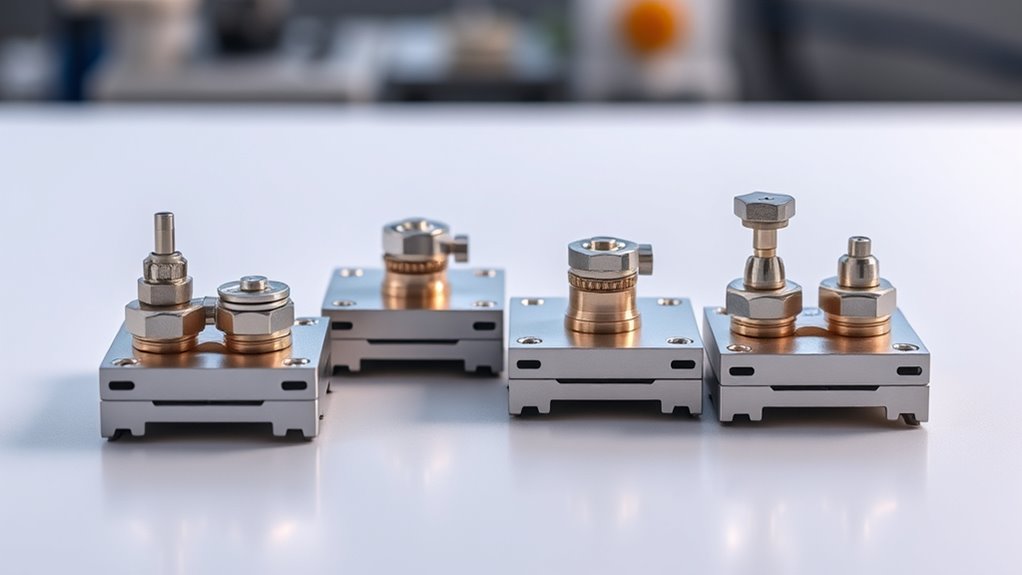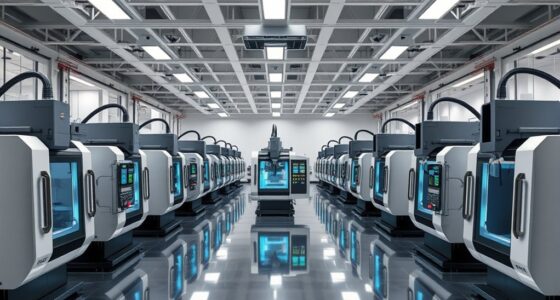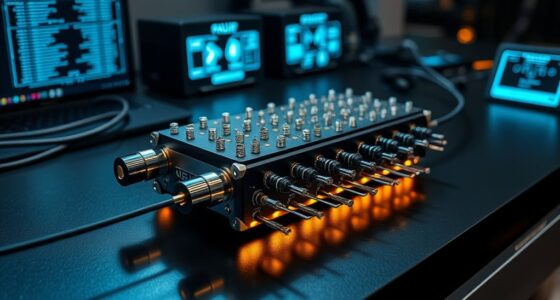When choosing the 4 best nanopositioning stages for 2025, I look for models that combine high load capacity, versatile travel ranges, and outstanding stability. Precision, durability, and compatibility with existing systems are key factors I focus on. Price also matters, so I balance features with my budget. If you keep these priorities in mind, you’ll find options that suit your needs. Stay with me, and you’ll discover the details behind top-performing stages.
Key Takeaways
- Prioritize stages with high load capacity and adjustable travel range for versatile precision applications.
- Select models featuring rigid construction and vibration damping to ensure stability and accuracy.
- Ensure compatibility with existing control systems and software for seamless automation.
- Consider cost-to-performance ratio to balance advanced features with budget constraints.
- Look for reputable brands offering reliable support, calibration, and maintenance services in 2025.
The Beginners Guide to Worm Farms and Vermicomposting
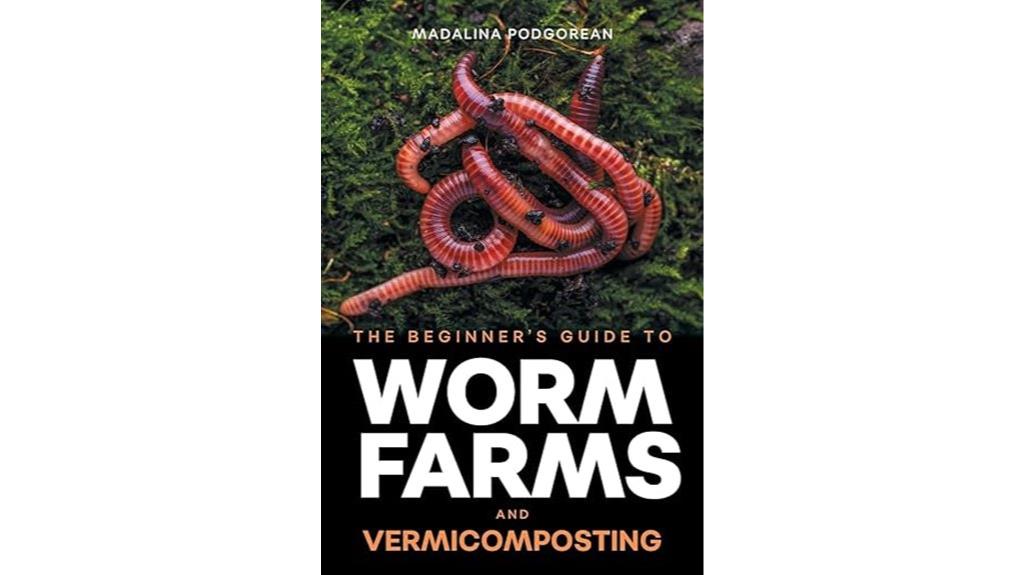
If you’re just starting out with vermicomposting, “The Beginners Guide to Worm Farms and Vermicomposting” is an excellent resource because it offers straightforward, step-by-step instructions tailored for novices. It covers essential topics like setting up a worm bin, choosing bedding, feeding worms, and troubleshooting common issues. The book uses helpful pictures and practical tips to make complex concepts accessible, even for beginners. While it’s mainly aimed at newcomers, some experienced worm farmers find it a bit disorganized. Overall, it’s a solid starting point that provides the foundational knowledge needed to begin and improve your vermicomposting journey.
Best For: beginners seeking a clear, easy-to-follow guide to start and improve their vermicomposting practices.
Pros:
- Provides straightforward, step-by-step instructions suitable for novices
- Uses helpful pictures and practical tips to simplify complex concepts
- Covers essential topics like bin setup, bedding, feeding, and troubleshooting
Cons:
- Some experienced worm farmers find the content somewhat disorganized
- Lacks detailed advanced techniques or DIY solutions for larger-scale systems
- The writing style can be generic and occasionally confusing, requiring rereading
The Magic of Momentum Book

The Magic of Momentum Book is ideal for anyone seeking practical strategies to build sustainable habits without relying on bursts of motivation. I’ve found that small, consistent actions create lasting change, and Guise’s approach emphasizes the power of momentum. Instead of waiting for motivation, he advocates breaking goals into tiny steps that accumulate over time. By working with resistance rather than against it, you can develop habits that stick. Practical tools like timers and whiteboards help organize daily wins, making progress feel achievable. This book shows how continuous, manageable effort can transform your life—no need for monumental efforts, just steady momentum.
Best For: individuals seeking practical, sustainable strategies to develop lasting habits and create meaningful change without relying on motivation.
Pros:
- Emphasizes small, manageable steps that lead to long-term success
- Practical tools like timers and whiteboards enhance daily organization and motivation
- Backed by psychological principles and real-world examples, making concepts easy to implement
Cons:
- Some readers may find the focus on tiny habits too incremental for rapid change
- The straightforward writing style might lack depth for those seeking more detailed academic insights
- The book’s emphasis on momentum may overlook situations requiring more intensive or structured interventions
Complete Guide to Ball Python Ownership and Care

This guide is perfect for both beginners and experienced snake owners who want a clear, practical resource on caring for Ball Pythons. It covers essential topics like enclosures, feeding, health, and bonding, providing straightforward advice for long-term success. Whether you’re just starting or have years of experience, you’ll find valuable tips to guarantee your snake stays healthy and comfortable. The guide emphasizes the importance of proper research, habitat setup, and responsible ownership, making it easier to create a safe environment. Despite its price, many see it as a worthwhile investment that enhances their understanding and enjoyment of Ball Python care.
Best For: both beginner and experienced snake owners seeking a clear, practical guide to caring for Ball Pythons and ensuring their long-term health and happiness.
Pros:
- Offers comprehensive coverage of essential topics like habitat setup, feeding, and health care.
- Provides straightforward, easy-to-understand advice suitable for all experience levels.
- Emphasizes responsible ownership and proper research, promoting safe and enjoyable pet-keeping.
Cons:
- The price may be high relative to the book’s size and content.
- Not an exhaustive resource; may require additional research for advanced topics.
- Focuses primarily on basic care, with limited detail on complex breeding or morph variations.
The Complete Guide to Axolotl Care and Ownership

For anyone seeking pinpoint accuracy in their movement control, nanopositioning stages are the ideal choice. When caring for axolotls, precision in habitat setup, water quality, and maintenance is vital. My experience shows that detailed guides, like the one I rely on, cover everything from tank preparation to breeding. Bright visuals and clear instructions make complex processes manageable, especially for beginners. Regular monitoring and proper environment adjustments ensure healthy, thriving axolotls. This extensive approach not only enhances care but also fosters responsible ownership, helping conserve this endangered species. Accurate, thorough guidance is essential for success in both care and conservation efforts.
Best For: beginner and experienced axolotl owners seeking a comprehensive, accurate guide to ensure proper care and conservation.
Pros:
- Detailed instructions covering all aspects of axolotl care, from habitat setup to health management
- Bright, colorful visuals that enhance understanding and visualization of proper care practices
- Emphasis on responsible ownership and conservation, promoting awareness of this endangered species
Cons:
- May be too detailed for casual or very new pet owners looking for quick tips
- Requires commitment to regular maintenance and monitoring, which might be demanding for some owners
- Some advanced breeding techniques might need supplementary resources for full comprehension
Factors to Consider When Choosing Nanopositioning Stages
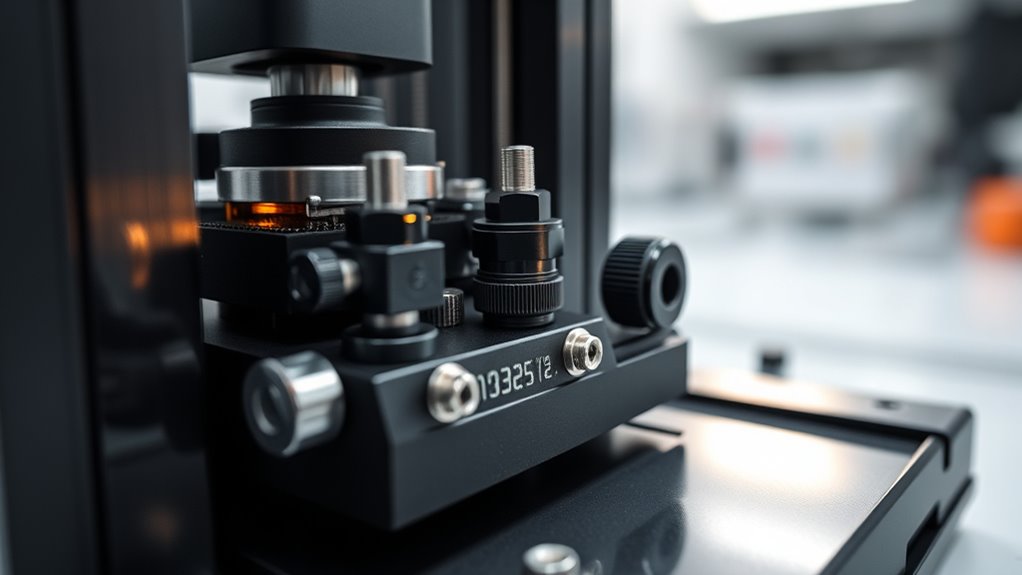
When selecting nanopositioning stages, I focus on key factors like precision, load capacity, and travel range to meet specific needs. Stability and rigidity are vital for maintaining accuracy, while compatibility features ensure seamless integration with existing systems. Understanding these points helps me choose the right stage for reliable, precise movement.
Precision and Resolution
How do you choose the right nanopositioning stage for your application? Focus on its precision and resolution. Precision often ranges from sub-nanometer to a few nanometers, allowing for highly accurate movements essential in microscopy, laser machining, and scientific research. Resolution, the smallest incremental movement the stage can make, is measured in nanometers or fractions, enabling finer adjustments. Achieving ideal precision and resolution depends on the actuator type, feedback system quality, and mechanical stability. To maintain consistent performance, proper calibration, environmental control, and minimizing external vibrations are critical. When selecting a stage, consider your application’s specific precision requirements and ensure the stage’s capabilities align with those needs. High precision and resolution are key to achieving reliable, repeatable results in advanced nanoscale tasks.
Load Capacity Limits
Selecting a nanopositioning stage requires careful attention to its load capacity limits, as these determine the maximum weight it can reliably support without sacrificing accuracy or stability. If you exceed these limits, the stage’s components may deform, leading to errors in positioning. Manufacturers specify load capacities based on design, materials, and intended use, guaranteeing safe operation. It’s essential to consider both the weight of your sample or device and any attached accessories or fixtures. Properly matching the stage’s load capacity to your needs not only prevents mechanical failure but also extends the equipment’s lifespan. Overloading can compromise precision and stability, defeating the purpose of choosing a high-quality nanopositioning stage. Always verify load limits to guarantee optimal performance and durability.
Travel Range Flexibility
Travel range flexibility determines how much a nanopositioning stage can move within its designated area, impacting its suitability for various applications. A stage with high flexibility allows for precise positioning over larger distances, which is essential for tasks requiring extensive movement. The design, including mechanical components and drive systems, directly influences this capability. Some stages feature adjustable travel limits or customizable ranges, accommodating different experimental or manufacturing needs. When selecting a stage, I consider my application’s specific movement requirements and balance travel range with other factors like stability and resolution. Having the right flexibility ensures I can perform both fine adjustments and broader positioning without sacrificing accuracy. Ultimately, choosing a stage with appropriate travel range flexibility enhances efficiency and precision in complex nanopositioning tasks.
Stability and Rigidity
When choosing a nanopositioning stage, stability and rigidity become key factors because they directly influence positioning accuracy and repeatability. Achieving stability relies on a rigid construction that minimizes flexing and deformation under load. Material choice plays an essential role; materials like granite or hardened steel provide excellent rigidity and vibration resistance. Design features such as cross-bracing and reinforced components further enhance stability during precise movements. It’s also necessary to balance the stage’s load capacity with its structural integrity to prevent sagging or misalignment. Vibration damping mechanisms and a low center of gravity contribute considerably to maintaining stability, especially in high-precision tasks. Ultimately, a stable, rigid stage ensures consistent, accurate positioning critical for demanding applications.
Compatibility Features
Ensuring compatibility features is crucial for nanopositioning stages to work effectively within existing systems. I look for stages that seamlessly integrate with current equipment, control systems, and mounting interfaces. Standardized mounting patterns and connector types are vital—they ensure the stage fits and functions properly with various instruments. Compatibility with specific software and control protocols also matters, as it allows for precise automation and synchronization during experiments or manufacturing. I also check the stage’s load capacity and travel range to match application needs, avoiding mechanical or operational issues. Additionally, power supply requirements and communication interfaces play a key role in reliable operation and smooth integration. These compatibility features ensure my nanopositioning system performs efficiently without unnecessary adjustments or complications.
Cost and Budget
Choosing the right nanopositioning stage often depends on your budget, as costs can vary widely from a few hundred dollars for basic models to several thousand for advanced systems. Your budget influences key features like load capacity, travel range, and resolution, shaping your options. Investing in a higher-priced stage usually means better precision, stability, and durability—crucial for sensitive applications. It’s important to deliberate not just the initial purchase price but also ongoing costs such as maintenance, calibration, and upgrades. Establishing a clear budget helps you find the right balance between performance and affordability. By understanding your financial limits, you can select a stage that meets your needs without overspending, ensuring you get the best value for your investment in precision movement.
Frequently Asked Questions
How Do Nanopositioning Stages Compare With Traditional Precision Movement Tools?
Nanopositioning stages outperform traditional precision tools by offering incredibly fine control at the nanometer scale, which is essential for advanced applications. I find they provide smoother, more accurate movement, thanks to piezoelectric actuators and advanced feedback systems. Unlike conventional tools, these stages deliver higher resolution and stability, making them ideal for cutting-edge research and manufacturing where even the smallest misalignments can compromise results.
What Future Technological Advancements Will Impact Nanopositioning Stage Capabilities in 2025?
Think of nanopositioning stages as explorers venturing into uncharted tech territories. In 2025, advancements like AI-driven control algorithms and ultra-stable materials will boost their precision and speed. I believe these innovations will make them more adaptable and reliable, opening new frontiers for nanotechnology applications. As these tools evolve, I see them becoming the backbone for breakthroughs in fields like quantum computing and biomedical research.
Are There Specific Industries Expected to Benefit Most From New Nanopositioning Stage Developments?
I believe the semiconductor and biotech industries will benefit most from new nanopositioning stage developments. As someone working closely with cutting-edge tech, I see these stages enabling even greater precision in chip manufacturing and tissue analysis. These advancements will streamline processes, improve accuracy, and accelerate innovation. If you’re in these fields, staying updated on nanopositioning tech could give you a significant edge in achieving your goals.
How Does Environmental Stability Affect Nanopositioning Stage Performance?
Environmental stability is like the foundation of a house—if it’s shaky, everything above suffers. For nanopositioning stages, even tiny temperature changes, vibrations, or air currents can throw off precision. Maintaining a controlled environment guarantees consistent, accurate movements. When conditions stay steady, I find the stages perform reliably, delivering the nanometer-level accuracy needed in advanced research and manufacturing. Without this stability, achieving precise results becomes a real challenge.
What Are the Maintenance and Calibration Requirements for High-End Nanopositioning Stages?
I regularly check the calibration of my high-end nanopositioning stages to guarantee accuracy, typically every few months or after any major usage. I also keep the stages clean and free from dust, and I follow the manufacturer’s maintenance guidelines, like inspecting for wear and lubricating moving parts if needed. Proper maintenance and calibration are essential to keep my equipment performing at its best and to maintain precision.
Conclusion
So, after all this talk about the tiniest movements and precision stages, you’d think I’d be an expert by now. Funny enough, choosing the perfect nanopositioning stage feels almost as delicate as caring for a pet axolotl—both require patience and a steady hand. Who knew that in 2025, the tiniest tweaks could make all the difference? But hey, if I can master this, maybe you can too. Precision isn’t just for scientists—it’s for anyone willing to get a little small.
